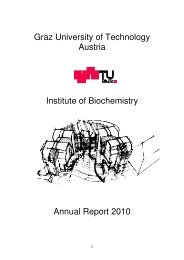Staff Members of the Institute of Biochemistry, TU - Institut für ...
Staff Members of the Institute of Biochemistry, TU - Institut für ...
Staff Members of the Institute of Biochemistry, TU - Institut für ...
Create successful ePaper yourself
Turn your PDF publications into a flip-book with our unique Google optimized e-Paper software.
Zn-dependent Alkylsulfatases<br />
Hydrolysis <strong>of</strong> alkylsulfates is an important pathway for soil and o<strong>the</strong>r bacteria to mobilize<br />
sulfur. Three classes <strong>of</strong> sulfatases - divided according to <strong>the</strong>ir reaction mechanism - have been<br />
discovered, and <strong>the</strong> recently elucidated structure <strong>of</strong> SdsA1 from Pseudomonas aeruginosa is<br />
ano<strong>the</strong>r example <strong>of</strong> <strong>the</strong> widely occurring family <strong>of</strong> metallo-ß-lactamases. This group <strong>of</strong><br />
alkylsulfatases is characterized by two Zn 2+ atoms in <strong>the</strong> active site which activate a water<br />
molecule for nucleophilic attack on <strong>the</strong> sulfate group. SdsA1 mainly cleaves long-chain<br />
primary alkylsulfates (preferred substrate is dodecylsulfate) by stereoinversion. In o<strong>the</strong>r<br />
words, <strong>the</strong> hydroxyl group attacks <strong>the</strong> carbon atom in <strong>the</strong> course <strong>of</strong> <strong>the</strong> reaction. Recently, a<br />
novel enzyme could be identified in Pseudomonas DSM 6611 (termed PISA1 = Pseudomonas<br />
inverting alkylsulfatase 1) which mainly cleaves secondary alkylsulfates, for example 2octylsulfate<br />
exhibiting stereopreference for <strong>the</strong> (R)-stereoisomer. In contrast to <strong>the</strong> majority <strong>of</strong><br />
hydrolases, which do not alter <strong>the</strong> stereochemistry <strong>of</strong> <strong>the</strong> substrate during catalysis, PISA1 is<br />
an attractive enzyme for <strong>the</strong> deracemisation <strong>of</strong> sec-alcohols.<br />
Analysis <strong>of</strong> <strong>the</strong> crystal structures <strong>of</strong> PISA1 and SdsA1 showed that <strong>the</strong> overall structure <strong>of</strong><br />
both proteins is virtually identical and both enzymes largely share <strong>the</strong> same active-site<br />
architecture, such as a sulfate binding site (composed <strong>of</strong> two Arg), a nucleophile site<br />
composed <strong>of</strong> a binuclear Zn 2+ -cluster typical for metallo-ß-lactamases and an Asn/Thrhydrogen<br />
binding network for substrate positioning. However, <strong>the</strong> active site <strong>of</strong> PISA1<br />
features several conspicuous amino acid exchanges (see figure below: in blue active side<br />
residues in SdsA1 and green those in PISA1).<br />
Phe/Gly Tyr/His<br />
Ala/Ile<br />
Tyr/Ser<br />
Met/Ser<br />
These amino acids are now subject <strong>of</strong> an extensive mutagenesis program to define <strong>the</strong>ir role<br />
in governing substrate preference <strong>of</strong> <strong>the</strong> reaction. This project is a close collaboration with<br />
Pr<strong>of</strong>s. Faber (biocatalysis) and Wagner (structure determination) from <strong>the</strong> University <strong>of</strong> Graz<br />
(<strong>the</strong>sis project <strong>of</strong> Tanja Knaus in our laboratory and Markus Schober in Pr<strong>of</strong>. Faber’s<br />
laboratory).<br />
12<br />
Met/Ser<br />
Tyr/Ser<br />
Leu/Pro<br />
Ala/Ile














